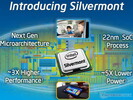
Test Medion Akoya P2214T MD 99430 Convertible
Intel Celeron N2940 | Intel HD Graphics (Bay Trail) | 11.60" | 1.6 kg

Der Intel Celeron N2940 ist ein sparsamer Quad-Core-SoC aus dem Einstiegssegment. Er taktet mit 1,83 - 2,25 GHz und gehört der Bay Trail-M Plattform an. Dank eines speziell für Low-Power-Chips optimierten 22-Nanometer-Prozesses (P1271) mit Tri-Gate-Transistoren konnte die Performance sowie die Energieeffizienz gegenüber dem Vorgänger deutlich gesteigert werden. Eine Besonderheit ist der schnelle integrierte Quick Sync Encoder sowie die Unterstützung von Wireless Display.
Architektur
Die Prozessorkerne basieren auf der neuen Silvermont-Architektur, welche erstmals bei einem Atom-Prozessor als Out-of-order-Design ausgeführt wurde. Die dadurch erhöhte Auslastung der Pipeline sowie viele weitere Detailverbesserungen (optimierte Sprungvorhersage, vergrößerte Buffer, verbesserte Decoder) sollen die Pro-MHz-Leistung um etwa 50 Prozent steigern. Gleichzeitig entfällt allerdings das Hyper-Threading-Feature der Vorgängermodelle. Weitere wichtige Änderungen umfassen die Unterstützung neuer Befehlssatzerweiterungen wie SSE 4.1 und 4.2 sowie AES-NI (modellabhängig).
Performance
Dank 4 CPU-Kernen und der verbesserten Mikroarchitektur übertrifft die Performance bisherige Atom-Modelle wie den Z2760 deutlich. Damit liegt der Celeron N2940 sogar auf Augenhöhe mit AMDs Kabini-APUs wie dem AMD A4-5000, sodass ausreichende Leistungsreserven für die meisten Office- und Multimedia-Anwendungen bestehen. Lediglich anspruchsvollere Software wird den Einstiegs-SoCs überfordern.
Grafik
Die HD Graphics (Bay Trail) basiert auf Intels-Gen7-Architektur, welche DirectX 11 unterstützt und auch bei den Grafiklösungen der Ivy-Bridge-Serie (z.B. HD Graphics 4000) zum Einsatz kommt. Mit nur 4 EUs und 313 - 854 MHz Taktrate fällt die Leistung aber noch deutlich niedriger als bei der HD Graphics (Ivy Bridge) aus, sodass nur ältere und weniger anspruchsvolle Windows-Spiele flüssig dargestellt werden. Obwohl selbst dies ein drastischer Fortschritt gegenüber dem Vorgänger ist, reicht die GPU-Performance nicht an konkurrierende AMD-APUs heran.
Leistungsaufnahme
Der gesamte SoC wird von Intel mit einer TDP von 7,5 Watt spezifiziert, sodass der Chip auch in sehr kompakten Subnotebooks oder Tablets (teils ohne Lüfter) eingesetzt werden kann. Bei typischer Nutzung soll die Leistungsaufnahme bei nur 4,5 Watt liegen (SDP).
| Codename | Bay Trail-M | ||||||||||||||||||||||||||||||||||||||||||||||||||||
| Serie | Intel Celeron | ||||||||||||||||||||||||||||||||||||||||||||||||||||
Serie: Celeron Bay Trail-M
| |||||||||||||||||||||||||||||||||||||||||||||||||||||
| Taktung | 1830 - 2250 MHz | ||||||||||||||||||||||||||||||||||||||||||||||||||||
| Level 1 Cache | 224 KB | ||||||||||||||||||||||||||||||||||||||||||||||||||||
| Level 2 Cache | 2 MB | ||||||||||||||||||||||||||||||||||||||||||||||||||||
| Anzahl von Kernen / Threads | 4 / 4 | ||||||||||||||||||||||||||||||||||||||||||||||||||||
| Stromverbrauch (TDP = Thermal Design Power) | 7.5 Watt | ||||||||||||||||||||||||||||||||||||||||||||||||||||
| Herstellungstechnologie | 22 nm | ||||||||||||||||||||||||||||||||||||||||||||||||||||
| Max. Temperatur | 105 °C | ||||||||||||||||||||||||||||||||||||||||||||||||||||
| Socket | FCBGA1170 | ||||||||||||||||||||||||||||||||||||||||||||||||||||
| Features | HD Graphics (Bay Trail, 313 - 854 MHz), Quick Sync, Wireless Display, Speedstep | ||||||||||||||||||||||||||||||||||||||||||||||||||||
| GPU | Intel HD Graphics (Bay Trail) (313 - 854 MHz) | ||||||||||||||||||||||||||||||||||||||||||||||||||||
| 64 Bit | 64 Bit wird unterstützt | ||||||||||||||||||||||||||||||||||||||||||||||||||||
| Architecture | x86 | ||||||||||||||||||||||||||||||||||||||||||||||||||||
| Vorgestellt am | 22.05.2014 | ||||||||||||||||||||||||||||||||||||||||||||||||||||
| Produktinformationen beim Hersteller | ark.intel.com | ||||||||||||||||||||||||||||||||||||||||||||||||||||

HP Chromebook 14-ak045wm: Intel HD Graphics (Bay Trail), 14.00", 1.7 kg
Externer Test » HP Chromebook 14-ak045wm
HP Chromebook 14 G4: Intel HD Graphics (Bay Trail), 14.00", 1.7 kg
Externer Test » HP Chromebook 14 G4
Lenovo IdeaPad 100-14IBY: Intel HD Graphics (Bay Trail), 15.60", 2 kg
Externer Test » Lenovo IdeaPad 100-14IBY
Lenovo ThinkPad 11e: Intel HD Graphics (Bay Trail), 11.30", 1.5 kg
Externer Test » Lenovo ThinkPad 11e
Lenovo Ideapad 100-14-80MH000YUS: Intel HD Graphics (Bay Trail), 14.10", 1.9 kg
Externer Test » Lenovo Ideapad 100-14-80MH000YUS
Medion Akoya P2214T MD 99430: Intel HD Graphics (Bay Trail), 11.60", 1.6 kg
Externer Test » Medion Akoya P2214T MD 99430
» Vergleich mobiler Prozessoren
Alle CPU Serien für Notebooks mit kurzer Beschreibung
» Mobile Prozessoren - Benchmarkliste
Sortier- und filterbare Benchmark-Liste